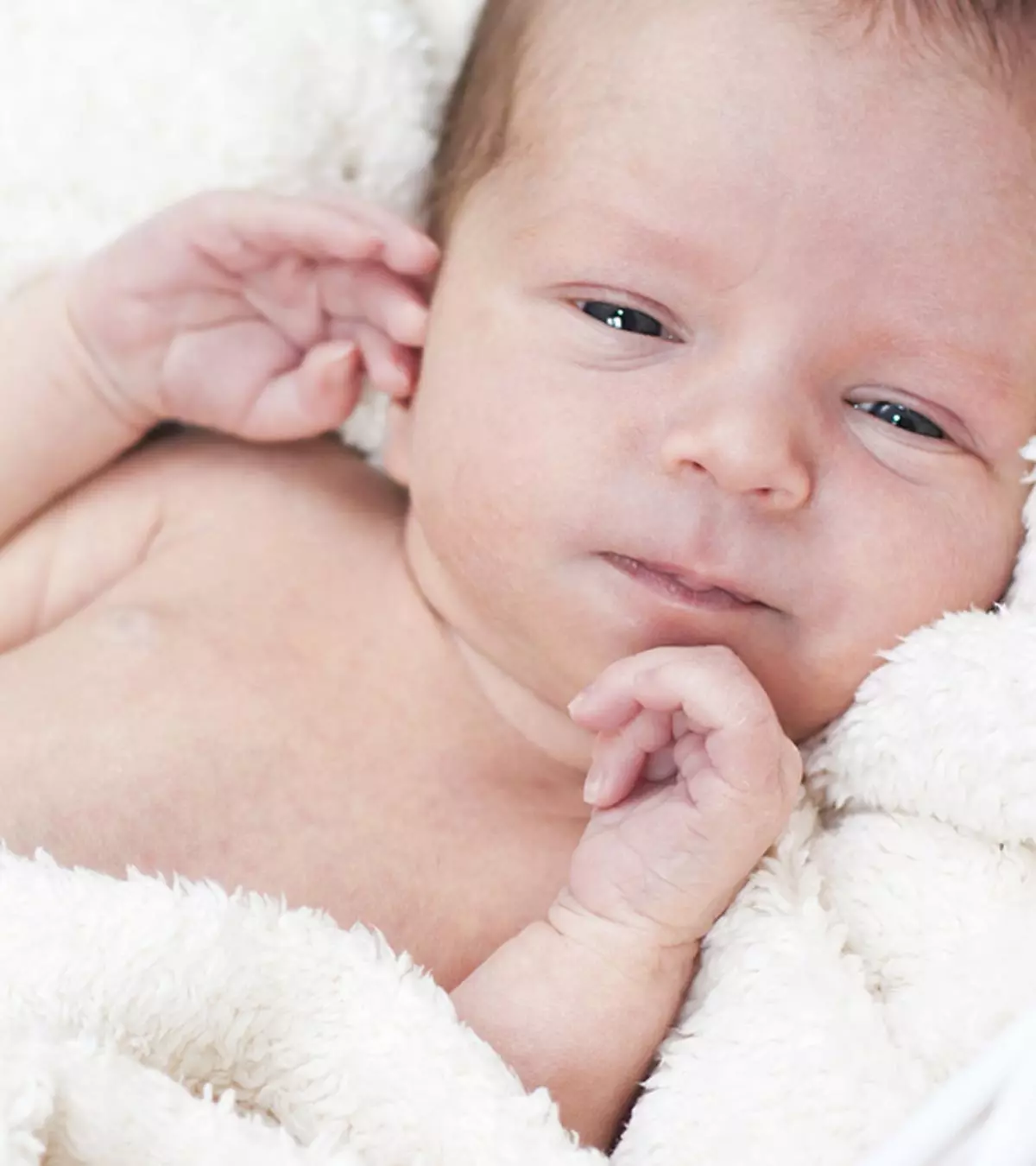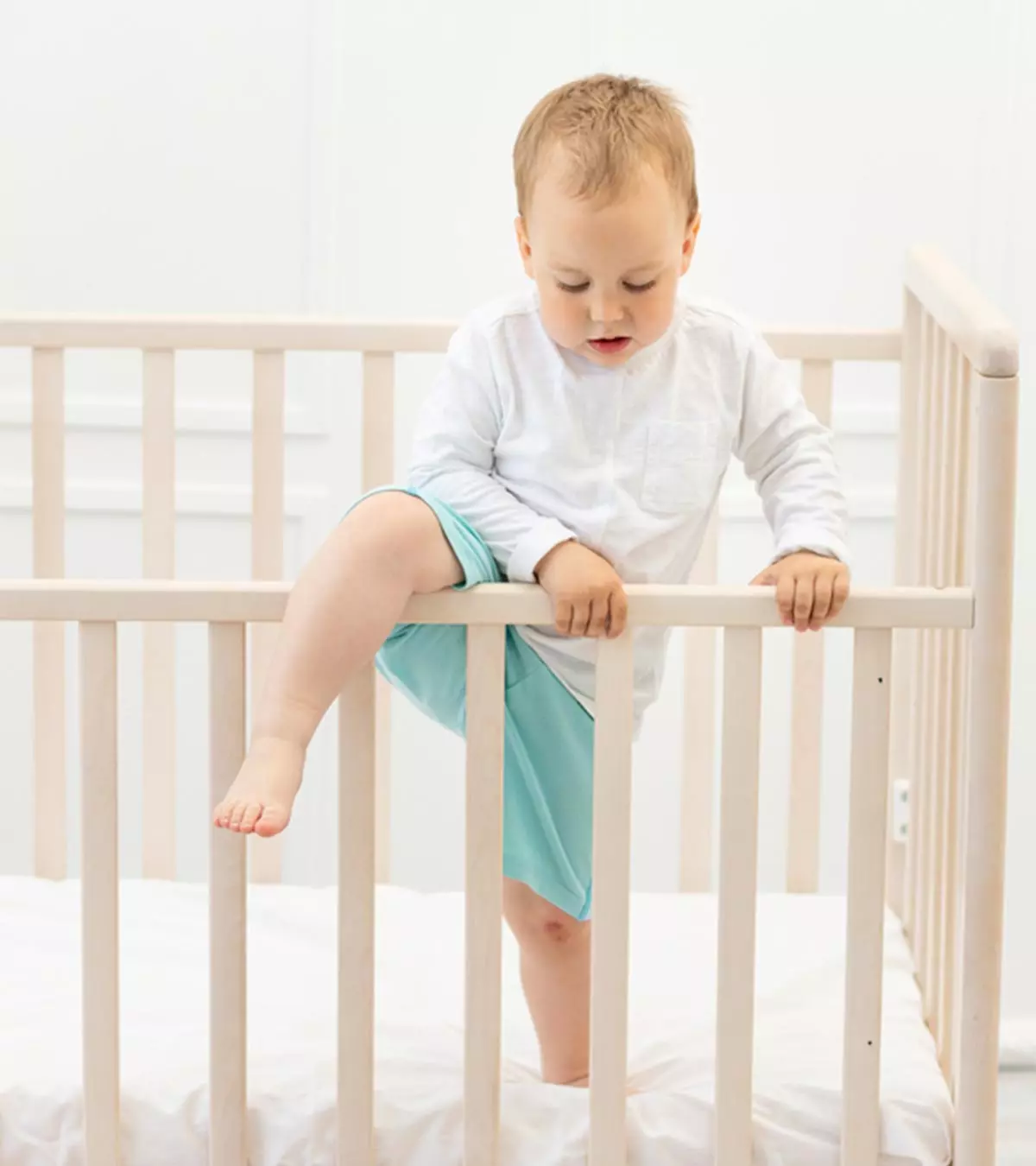
Image: Shutterstock
It is important to identify baby sleep cues to help them sleep better. You will find it difficult to put an overly exhausted baby to sleep, or they might wake up more often in the night. A common mistake most parents make is waiting for the baby to get tired and fussy before putting them to bed, as they think these are the signs that the baby is ready to sleep.

However, before hitting crankiness and crying, the babies give subtle cues to show they are sleepy, similar to the cues they show when hungry. So identifying and designing bedtimes based on these cues can make it easy for you to put your baby to sleep. Read on to know.
Key Pointers
- Parents can identify their baby’s proper bedtime with sleep cues, avoiding the need to wait for fussiness or crying.
- A sleepy baby may exhibit signs such as yawning, eye-rubbing, reduced playfulness, and crankiness.
- Parents should observe them closely and track their nap and wake times, to understand their baby’s sleep patterns and energy levels.
- Sleep cues help children sleep well, establish a routine for feeding and napping, and prevent irritability from exhaustion.
- To help babies sleep, dress them comfortably, provide a quiet and dark environment, lay them in their crib before they fall asleep, feed and change them beforehand, and read or sing to them.
What Are The Common Baby Sleep Cues?
Here are some of the sleep cues a baby shows before they get overtired and fussy.
- Yawning is one of the first few signs of a sleepy baby (1).
- The baby rubs their eyes and pulls or rubs their ears (2).

- Drooping eyelids are also noticeable.
- Babies also exhibit their sleepiness through the jerky movement of hands and legs.
- They smile less than usual.
- Some babies suck thumb or fingers when they are sleepy. It is a way to self-soothe.
- When babies are extremely sleepy, they might become cranky, fussy, and irritable and might end up crying if not put to bed (3).

When babies sleep after they are extremely cranky, they may not have a good quality sleep. The baby fights sleep, wakes up often or sooner, and remains irritable or cranky.
How To Identify Your Baby’s Sleep Cues?
A newborn’s sleep cues may go unnoticed in the early days. However, you will eventually learn to identify them. We give you a few tips to help you identify the cues and improve the baby’s sleep schedule.
- Pay close attention to your baby to identify his or her behavioral changes. Most babies become a little silent and less active before getting fussy and cranky. Identifying the correct time will help you put your baby to sleep faster.
- Notice the infant sleep pattern every day and understand their wake-time length. Most babies have a fixed schedule of the number of hours they can be awake and be playful before they feel sleepy again.
- Document your baby’s sleeping cues. Make notes of how your baby reacts and acts when he/she is sleepy. It will help you remember the changes in the baby’s sleep behavior and set sleep patterns accordingly.
 Do remember
Do remember
- Note down the number of hours your baby sleeps every day and also the time duration your baby can tolerate happily between two naps. Try to follow these leads to achieve a good sleep schedule for your baby.
If your baby shows sleeping cues, then it is recommended to put the baby to bed as early as possible to avoid extreme tiredness and irritability.
Tips To Put Your Baby To Sleep After Identifying Cues
Once you learn to identify your baby’s sleep cues, it becomes easier to decide the right time for the baby’s nap. Following these parenting tips might help you put your sleepy baby to bed.
- Babies thrive on routine. Establish the sleep routine and baby sleep schedule.
- Dress the baby in comfortable clothes according to the weather.

- Sleep environment also plays a vital role. If your baby is hypersensitive to sound and light, then keep the baby’s crib in a dark and quiet room.
 Point to consider
Point to consider- You can either pat, rock, cradle, or swaddle the baby to sleep. Once the baby is older, you may provide sleep training and encourage them to sleep on their own by laying them in their crib when they are partially awake and sleepy. This is very important to prevent habit formation where you as parent become the “it” for your baby to fall asleep.
- Make sure that the baby’s diapers are changed to maintain sleep hygiene and infant health, and that the baby’s stomach is full before putting them to bed. It can help them achieve uninterrupted and longer sleep.
- Try and establish a baby bedtime routine. Soothing and calming techniques like singing some nursery rhymes at bedtime might help the baby establish a correlation between the rhyme and sleeping. For older babies, bedtime stories might help them establish a routine.
- Sleep aids also help to overcome sleep regressions in babies (4).
A mother explains on her YouTube channel the cues she followed for her baby. She says, “So what we would do is I knew as a newborn that she would need to go to sleep within an hour and 15 minutes of waking up. Unfortunately, she would be nursing for about 45 minutes, so that didn’t give us a lot of time to do anything, but around 45 minutes to maybe 50 minutes, we would start maybe dimming the lights or trying to walk her around and speak in a soft voice so that she knew that she was going to sleep soon so we would just calm her down first around five to ten minutes prior to her sleepy cues and then when her sleepy cues would begin she was ready to be put down, and she would fall asleep (i).’’
Frequently Asked Questions
1. How do I know if my baby is sleepy or lethargic?
You may know if your baby is sleepy or lethargic by a few changes in their behavior. A sleepy baby might feel energetic after a good nap. Whereas a lethargic baby may be tired most of the time, sleep more than usual, and not be as attentive as always. Lethargy could be a sign of an illness.
2. Should I put the baby down for a nap if they’re yawning?
Yawning is a good indicator that the baby is tired and sleepy. If you find that your baby is constantly yawning and has been showing other signs of tiredness such as eye-rubbing, declining interaction, fussiness, etc., it might be time for you to put them to sleep.
3. Do sleep cues change as a baby grows and develops?
Yes, sleep cues may change as a baby grows and develops. Their sleep patterns, cues, and needs evolve as they progress through different developmental stages. The sleep pattern for a 1-month-old is quite different from the sleep pattern for a 10-month-old. Understanding and adapting to these changes can help parents establish appropriate sleep routines and support their baby’s healthy sleep habits.
4. How can parents manage sleep cues when their baby is developing a growth spurt or developmental leap?
Parents may need to adjust their approach to managing sleep cues when their baby develops a growth spurt or developmental leap. This can include providing extra comfort, doing more skin-to-skin contact, offering more frequent feedings, and allowing for an additional nap or sleep time. Being responsive to the baby’s changing needs and providing a calm and soothing environment can help support their sleep during these periods of growth and development.
5. How can parents differentiate between newborns’ sleep and hunger cues?
Differentiating between sleep cues and hunger cues in newborns can be challenging. However, some general cues can help parents distinguish between the two. Signs of sleepiness may include eye rubbing, yawning, fussiness, or decreased activity. Hunger cues can manifest as rooting, sucking motions, lip smacking, or increased alertness. It’s important for parents to observe their baby’s overall behavior, consider the timing since the last feeding, and respond to their needs accordingly, whether it be offering comfort for sleep or providing feeding for hunger.

It’s difficult to recognize a baby’s sleep cues in the early days because they sleep most of the time and only wake up to eat and poop. However, you may better understand their needs, routines, and sleep patterns as they become older. Although each baby has different sleeping requirements, yawning, drooping eyelids, and less activity are some common baby sleep cues. After you identify these cues, help them get ready for bed by dressing them in comfortable clothes, swaddling them, and ensuring the crib is in a dark and quiet place.
Infographic: Common Sleeping Cues In A Baby
Baby actions that indicate sleep readiness are known as sleep cues. Understanding and reacting to a baby’s sleep cues is critical to ensure that a baby has a good night’s sleep. So, check out the infographic below to learn about common signs that indicate your baby is tired and sleepy. Illustration: Momjunction Design Team
Illustration: Common Baby Sleep Cues And How To Identify Them?

Image: Stable Diffusion/MomJunction Design Team
Discover effective techniques to identify your infant’s fatigue cues, facilitating quicker sleep. Explore the optimal approaches for a peaceful bedtime routine in order to promote restful nights.
Personal Experience: Source
MomJunction articles include first-hand experiences to provide you with better insights through real-life narratives. Here are the sources of personal accounts referenced in this article.
i. Baby Wake Windows By Age | ++ Sleepy Cues to Lookout For.https://www.youtube.com/watch?v=EUr3FFyayC0
References
1. Infant Sleep; Columbia University Department Of Neurology
2. Sleep in Infants (2-12 Months); Nationwide Children’s
3. Children and Sleep; Sleep Foundation Organization
4. Use of Sleep Aids During the First Year of Life; National Library of Medicine
5. Sleep 0 – 3 months; Women’s and Children’s Health Network
Community Experiences
Join the conversation and become a part of our nurturing community! Share your stories, experiences, and insights to connect with fellow parents.
Read full bio of Dr. Elna Gibson
Read full bio of Dr. Ritika Shah
Read full bio of Rohit Garoo
Read full bio of Shinta Liz Sunny
















